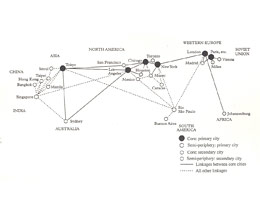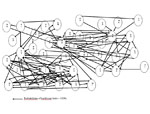Networked City
If traditionally cities' hierarchies within the economic system were based on internally structured power centers, the current role of cities within the global economy depends on their connectivity as to the transport and telecommunication networks. Networked Cities thus appear that are a collection of urban nuclei that operate as nodes of a world economic network. This is possible thanks to telematic networks, which have permitted the connection of cities between themselves. The Networked City seeks the generation of synergies and is based on the complementarity between its various components, which makes them interdependent.

 The concept of the Networked City occurs on three different scales. The first of these, which we have just commented on, refers to the connection of a series of cities on a global level. In these cases what makes up the Networked City is not complete cities but rather key areas such as business centers, airports, logistic areas, etc. The second refers to the connection of cities on a metropolitan level. The city of Montpellier has established a network of broadband lines that connects it to the main cities of its surrounding area. It is a case of their complementing each other so that the urban region is more competitive on a global level. Finally, urban networks within a single city are also generated. Kawasaki is carrying out a plan based on the creation of 18 "smart squares," quarters that are perfectly equipped from the technological point of view, specialize in a specific type of industry, and are interconnected among themselves. The idea is to create the first "online city" on the planet.
The concept of the Networked City occurs on three different scales. The first of these, which we have just commented on, refers to the connection of a series of cities on a global level. In these cases what makes up the Networked City is not complete cities but rather key areas such as business centers, airports, logistic areas, etc. The second refers to the connection of cities on a metropolitan level. The city of Montpellier has established a network of broadband lines that connects it to the main cities of its surrounding area. It is a case of their complementing each other so that the urban region is more competitive on a global level. Finally, urban networks within a single city are also generated. Kawasaki is carrying out a plan based on the creation of 18 "smart squares," quarters that are perfectly equipped from the technological point of view, specialize in a specific type of industry, and are interconnected among themselves. The idea is to create the first "online city" on the planet.
The connectivity of the city has become an important aspect of the contemporary world (its prosperity depends on its situation on the network), which some consider that should be included among the priorities of town planning.
Bibliography
- MITCHELL, William J. Me. The cyborg self and the networked city. Cambridge, MA: MIT Press, 2003.
Links
- ParoleDictionary on the contemporary city
- UrbanwordsUrban Planning dictionary